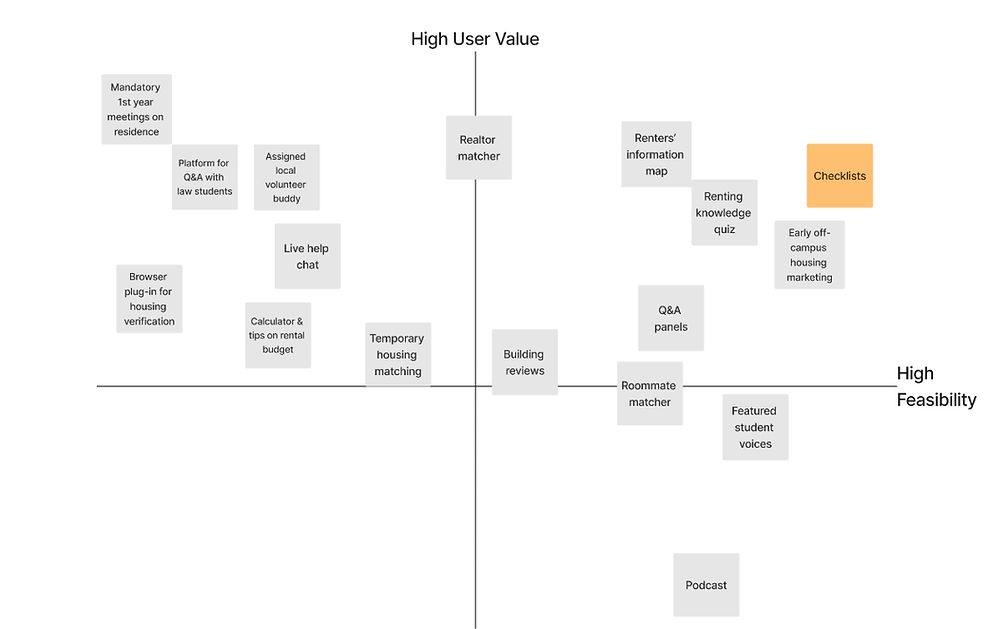
Rent Smart
A mobile app helping university students find off-campus housing in Toronto

I designed a mobile app with succinct apartment viewing checklists and clear, bite-size educational resources for student renters in Toronto.
01
At a Glance
Duration: Sept - Dec 2024
Context: Class project for a Master's level Fundamentals of UX course
Team: Yixin Guo, Olivia Ou, Amanda Wang, Caitlin Wong
Tools: Figma, Miro, Canva, Microsoft Office (Excel, PowerPoint, Project)
My Key Responsibilities:
-
Conducted user interviews and usability testing
-
Completed background research and competitive analyses
-
Ideated main app features
-
Presented design solutions at Playback meetings
-
Led project management and tracked progress
Problem Statement: Help post-secondary students in Toronto feel safer and more confident when finding off-campus housing
02
Project Stages
Toronto is experiencing an unprecedented housing crisis. More and more people face housing precarity or even homelessness. Low- and middle-income post-secondary students are often disproportionately affected by city-wide housing challenges. How can we best support these students in finding safe, budget-friendly off-campus rentals?
We use the following design stages to understand and address this issue.
-
Background Research
-
Problem Definition
-
Ideation
-
Prioritization
-
Wireframe Creation
-
Usability Testing
-
Pivoting
-
UI Design
I illustrate these stages in the project timeline in a Gantt chart below.

03
Background Research
Findings
-
Toronto is experiencing a housing crisis.
-
Low availability: There are limited rental units available on the market.
-
Low affordability: Rental units are too expensive for students.
-
Predatory or unlawful landlord practices: Landlords often demand upfront deposit payments exceeding legal amounts.
-
Additional burdens on students with marginalized identities
-
Methodology
We conducted both primary and secondary background research.
First, we completed secondary research on Toronto's housing market, existing tools, and key stakeholders. I used an environmental scan to contextualize Toronto's housing crisis and how it disproportionately affects non-local, post-secondary students. Furthermore, I identified both individual and institutional stakeholders. I also outlined existing tools and resources, from university resources to community legal services, building a foundation for our competitor analysis.
For the primary research, I drafted the interview guide and conducted two semi-structured user interviews. I coded the results, synthesized the themes, and created the structure of the affinity diagram (attached below).

04
Problem Definition
From our research insights, I proposed the problem statement: we want to help post-secondary students in Toronto feel safer and more confident when finding off-campus housing. To narrow down the scope, the team decided to use non-local students as our primary persona because they tend to face more housing challenges than those from the GTA.
05
Ideation
-
Individual Crazy 8's
-
Team Round Robin

06
Prioritization

We mapped product ideas based on user value and feasibility and identified “checklists” as an easy win. We plan to design apartment checklists with embedded explanations to help non-local students prepare for rental viewings.

Prior to usability testing, we thought combining a renters’ knowledge quiz with an information map would benefit users while showcasing our design skills.
08
Usability Testing
Method:
-
Five-second test
-
Think-aloud
-
Probing questions
Findings:
-
Almost all users (6 out of 7) correctly identified the app’s purpose within 5 seconds.
-
Most users (5 out of 7) were unsure about the purpose of the quiz (testing knowledge or matching rentals?) and expected to see listings.
-
Over half of the users (4 out of 7) found the label “Organizations” ambiguous.
-
Some users (2 out of 7) recommended adding educational resources (e.g., cheat sheets).
09
Pivoting
We decided to pivot to the checklist function and eliminate the quiz.
10
UI Design



11
Reflection
-
An arm's length from users: maintain distance between designers and users to avoid personal biases especially when designers and primary user groups share the same identities
-
Functions first: choose the idea that has the highest user value and reasonable feasability regardless of its simplicity and build the UI design from there


